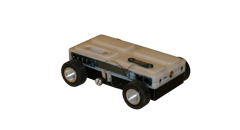
Mini Projects
Gestalt or not, a collection of minor projects. These include furniture, gizmos, art, and miscellaneous afternoon endeavors. The primary portfolio begins below.

Gestalt or not, a collection of minor projects. These include furniture, gizmos, art, and miscellaneous afternoon endeavors. The primary portfolio begins below.
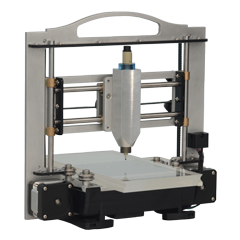
For years I have been chasing the idea of a portable automated multi-tool because I find great appeal in the notion of being able to take my tools with me on the road. The Magic Mill explores a new configuration of kinematics that optimizes for compactness, minimal moving mass, and most importantly untangles a variety of small machine design details that can become a real pain if ignored.
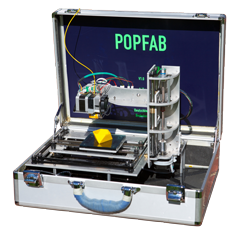
My collaborator Nadya Peek and I were asked to design this briefcase CNC multi-tool to perform "guerrilla urban interventions" as part of the BMW Guggenheim Project in Berlin. Building on prior work including Fab-in-a-Box and CoreXY, we developed a piece of carry-on luggage that can 3D print, vinyl cut, draw, and mill.
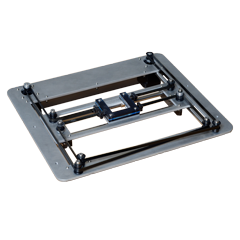
Many digital fabrication processes like 3D printing and laser cutting involve quickly moving a light toolhead. However most cartesian motion systems use serially stacked axes, meaning that one motor must push the mass of the other. CoreXY is a technique that uses a pair of serpentine belts to provide low-inertia cartesian motion by keeping both motors stationary, and also happens to be self-stabilizing. These properties enable a variety of novel machine architectures.
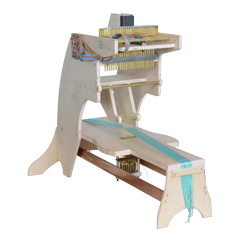
Jacquard looms were the world's first digital fabrication tools, and made it possible to weave intricate non-repeating patterns in fabric. This scaled-down Jacquard loom automates the conversion of a pattern into thread picks while maintaining the user's ownership of the overall weaving process. Perhaps the friendship bracelets made on this machine still retain the juju of the hand-made.
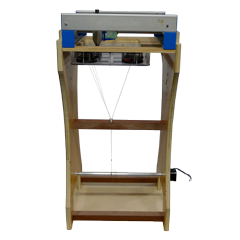
This computer-controlled braiding machine was created for Leah Buechley's class New Textiles at the MIT Media Lab. Up to five bobbins can be loaded with yarn, and are magnetically shuffled around each other to create unique braided structures.
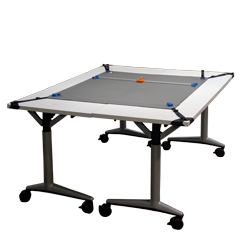
One of the biggest impediments to an open source clothing movement is the difficulty of sharing fabric cut patterns: most people don't have printers large enough to print patterns at home. Bot-of-the-Cloth is a large-format gantry plotter made out of fabric that borrows structure by stretching on a table or wall. It was also the motivation to develop the CoreXY motion system.
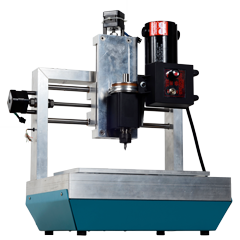
Milling machines are traditionally made from expensive precision-machined steel or aluminum to achieve both accuracy and stiffness. The frame of the Mighty Mill is made from concrete poured into thin-walled aluminum tube, resulting in a low-cost and rigid structure. Accuracy comes from a reusable fixture that holds the guide rails in place during casting.
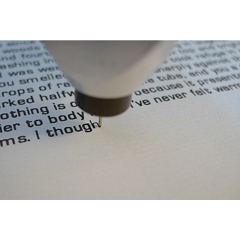
Have you ever written a letter without any intention of sending it? As an art project for the Cannytrophic Art Show in 2011, a robot methodically writes unsent love letters to passerby's. The resulting set of eight letters explores the notion of 'vertigo' as posed by Milan Kundera in his novel The Unbearable Lightness of Being.
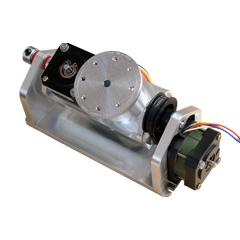
As an engineer, my tools infrequently travel with me. This project explores the idea of a portable, cohesive toolset for personal fabrication. A set of multi-purpose kinematic modules and interchangeable toolheads are tied together by a virtual-machine-based control system.

Creating a control system can be one of the most challenging elements of building a moving machine. This project develops a set of networkable control modules, each with a corresponding "virtual" software module. These building-blocks can then be combined to quickly prototype complex control systems.
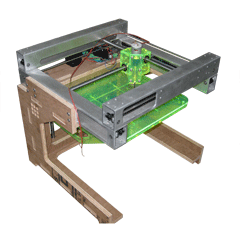
Most automated fabrication tools - whether additive or subtractive - consist of a 3-axis gantry and a toolhead. The FabMate collection of machine iterations provides an extensible universal gantry fast enough for 3D printing and stiff enough for light milling. Sponsored by the MIT Center for Bits and Atoms and created in collaboration with Maxim Lobovsky.
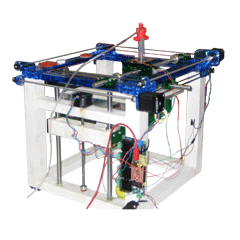
The Plaster Disaster was created with graduate students Maxim Lobovsky and Kwang Lim as our final project for MIT's "MAS.961: How to Make Something That Makes (Almost) Anything." Our goal was to build a fast and accurate 3D printer, in the spirit of Fab@Home , while examining the benefits (and weaknesses) of using plaster as the machine's primary structural material.
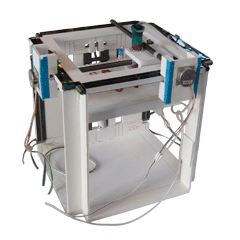
As a weekend project for MIT's "MAS.961: How to Make Something That Makes (Almost) Anything", I explored the low end of DIY 3D printing. This machine can be built at home in a day using a hot glue gun, an exacto knife, and less that $100 of materials and components. The use of foamcore as the primary structural component enables rapid iteration and easy experimentation.
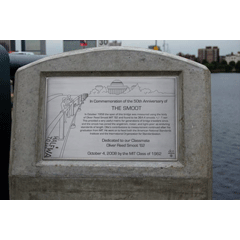
In the Fall of 1958, the Mass. Ave. Bridge linking MIT's campus with Boston's Back Bay was measured using the body of then-fraternity-pledge Oliver Reed Smoot. In 2008 the MIT Class of 1962 commissioned me to design and fabricate a commemorative titanium plaque and concrete post - now mounted at the head of the bridge. I completed this assignment in collaboration with Ken Stone of the MIT Hobby Shop and artist Melissa Rothstein.
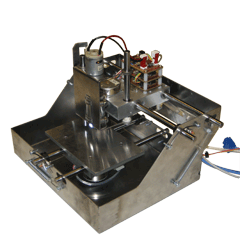
This circuit board milling machine was made as a component of my SB thesis entitled "Rapid Prototyping of Rapid Prototyping Machines." It was both an exploration in the design of low cost CNC machine tools and a test bed for developing a networked motor control system. The goal of the thesis was to develop techniques for simplifying the design and creation of new fabrication machines.
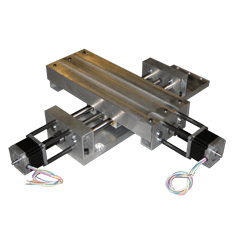
Integral to many DIY CNC projects is an XY stage - most are designed from scratch for each new project. As a component of my SB thesis entitled "Rapid Prototyping of Rapid Prototyping Machines," the design of this XY stage is defined entirely by its table travel and overall stiffness. Engineering calculations, appropriate component selection from McMaster-Carr, and engineering drawings are all generated automatically.

CAUTION: CONFLICTING EMOTIONS MAY RESULT IN A MENTAL STATE WHICH, WHILE IN STABLE EQUILIBRIUM, IS UNDER EXTREME TENSION. This photographic installation was created as my final project for MIT's "4.341: Introduction to Photography," and exhibited in the lobby of MIT's Brain and Cognitive Sciences Building.
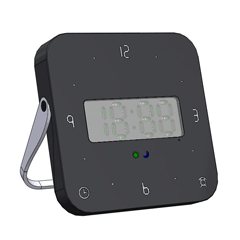
Most digital alarm clocks provide only two control buttons and require the user to scroll minute-by-minute and hour-by-hour to set an alarm. By realizing that five-minute resolution is adequate when selecting a wake-up time, this alarm clock simplifies the process by enabling direct time entry.

A yo-yo, or a pair of headphones? As a team project for MIT's manufacturing class, we designed and machined the molds which formed the plastic components of this unlikely object. Over 100 were made and measured as an introduction to the realities of manufacturing variability.
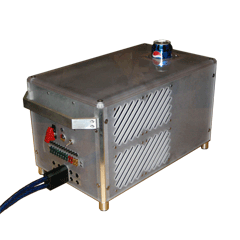
This device, created in collaboration with my friend Greg Schroll , uses thermoelectric cooling modules to chill a soda can from room temperature to 5 degrees Celcius in under two minutes. It received MIT's 2007 deFlorez Award for "outstanding ingenuity and creative judgement."

My entry for the culminating competition of MIT's introductory mechanical design class involved three months of intense creative design, analysis, solid modeling, and machining. The design was awarded MIT's 2006 Whitelaw Prize for "Originality in the Design of 2.007 Machine."
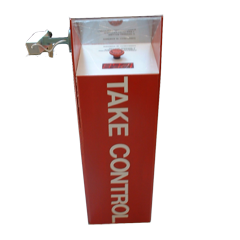
A public art piece for MIT's "4.301: Introduction to Visual Arts." This red podium urged observers to take control by depressing an emergency stop button situated below a digital clock.
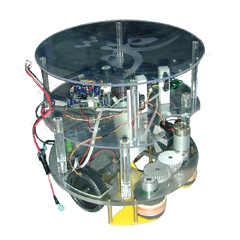
As part of a 4-person team, I designed and built the mechanical systems for a camera-guided robot capable of locating, capturing, and depositing items (red balls) autonomously. Our creation received the "Best Dressed Robot" award for its good looks and charm.
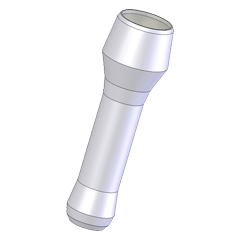
The aesthetic form of this flashlight was fashioned using the Golden Ratio design system as an exercise during my 3-week course of study at the Barnstone Studios. Upon returning to MIT, I served as the instructor for a 6-person CNC machining seminar at the Hobby Shop aimed at mass-producing the flashlight economically.
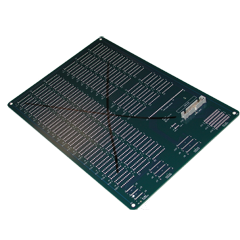
One of two major projects I completed as part of my summer internship at Apple Computer. This PCB made use of 1000 switches to arbitrarily connect a laptop keyboard matrix to its track-pad controller. I designed the circuit in Cadence, and then worked with a PCB layout engineer to generate traces and silkscreen artwork. The final product was professionally fabricated and stuffed.
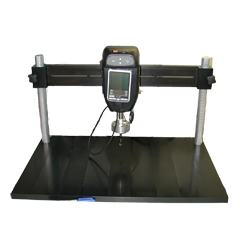
The other major project I completed as part of my summer internship at Apple Computer. This gantry supported a mini Instron force testing machine, and facilitated the characterization of laptop keyboards. I designed the components using Unigraphics, and then worked with Apple's Model Shop to create a final product. A second device was later made for Apple's Reliability Laboratory.

This pendulum-action golf ball launcher was the first time I had used CAD to completely design a project before construction. The effort led to 20 different types of parts represented by over 100 pages of mechanical drawings, most of which were machined from aluminum and 304 stainless steel.
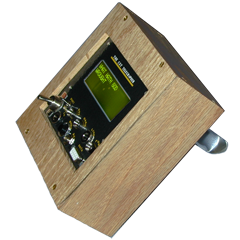
The Morse Code Interpreter uses a microprocessor to convert an incoming Morse Code signal into alphanumeric characters on an LCD screen. This project afforded me the enjoyable opportunity to combine aesthetic mechanical design with electrical engineering.
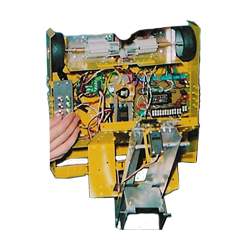
A hacky-sack firing autonomous vehicle. Motor speed, direction, and the launch of a hacky sack were all controlled using a microprocessor. The design was also my first experience using bent sheet-metal as structural elements.
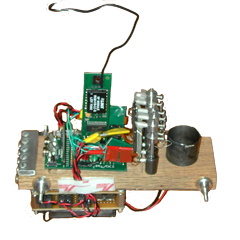
The challenge was to create a vehicle which would travel the farthest on one balloon's worth of compressed air. Using a series of microprocessor-controlled air valves, my device maintained a slow speed to avoid losing energy to viscous air drag.
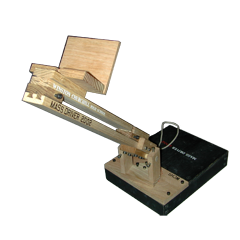
The Mass Driver was designed for the Maryland Space Business Roundtable's Final Frontiers Competition. It is machined entirely from red oak and features a rubber band powered catapult riding on a dovetail slide. My design received the "Best Engineering Award."
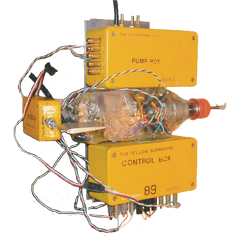
A radio-controlled submarine driven by a DC motor. Creating a submersible vehicle forced me to overcome water-induced hurdles by sealing the drive shaft, compartmentalizing the electronics, and devising a method to change depths.
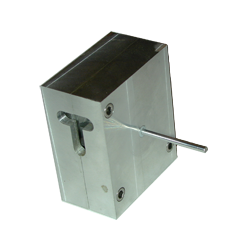
Machined entirely from aluminum and teflon, this air-driven turbine was my first entry into the University of Maryland Physics Olympics. Its power-to-weight ratio proved too low to make it a practical power plant for a balloon-powered car.
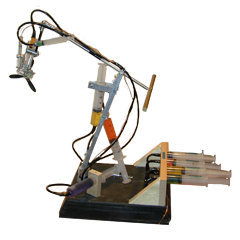
This hydraulically-actuated robotic arm was designed to surmount an 18 inch barrier and extinguish three candles as quickly as possible. Excluding the base, the robotic arm was entirely built on a milling machine and lathe, and contained over 33 individually machined parts. Materials used include aluminum, brass, copper, Teflon, carbon fiber, and wood.
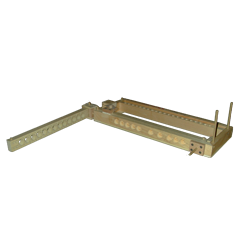
As an entry into the Maryland Space Business Roundtable's Final Frontiers Competition, the Satellite Snatch used a series of rope-linked pins to successively capture and retrieve 3 metal disks from the center of a table. My design was recognized with the "Best Engineering Award."
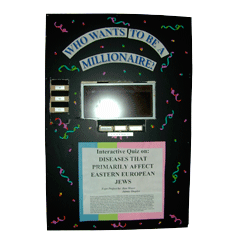
As an entry into the Maryland Space Business Roundtable's Final Frontiers Competition, the Satellite Snatch used a series of rope-linked pins to sucessively capture and retrieve 3 metal disks from the center of a table. My design was recognized with the "Best Engineering Award."